Getting Unstuck
August 2010
- by Kelvin Miyahira
Since I’ve laid out the Gracovetskian foundation for how the spine optimally works in the golf swing, perhaps it is time to revisit some common golf swing flaws that can easily be misdiagnosed if you’re into planeology or some other method that focuses on golf “technique” while virtually ignoring how the body was meant to move. As I see it, the body instinctually figures out the best way to move given a golf club in one’s hands and the task of hitting the ball on the ground or on a tee. And the best players in the world seem to find those optimal ways regardless of method being used.
But the average golfer does not have it so good. They typically don’t have the optimal moves and are taught just the fluff stuff and is rarely taught the real moves that the greatest golfers display. Imagine paying for a Ferrari, albeit unbeknownst to you, with a VW bug engine. You can own all the looks of a fast car but under the hood we know different.
The average golfer most likely has missing lateral bend or lordosis and this will certainly cause “golf technique” errors that are commonly Band-Aided and routinely covered up instead of fixed at the root. Therefore recurring problems will always exist because typical swing methods conjured up, consider the spine to be just a bony appendage on your back that stays in a two-dimensional straight line during the swing.
So let’s take a look at some commonly misdiagnosed swing flaws so that you can effectively correct the true source of the problems rather than Band-Aid them. So let’s take a look at how golfers can get stuck so that we can get to the root of this often misunderstood problem.
Here’s the great violinist from the Philadephia Orchestra, Rich Amoroso again to help us understand how he got stuck and how he fixed the problem. When he did this right for the first time, he exclaimed, “I’ve never done this before.” And based on what I’ve seen, most people don’t get this right and learn to live with their “disability.”


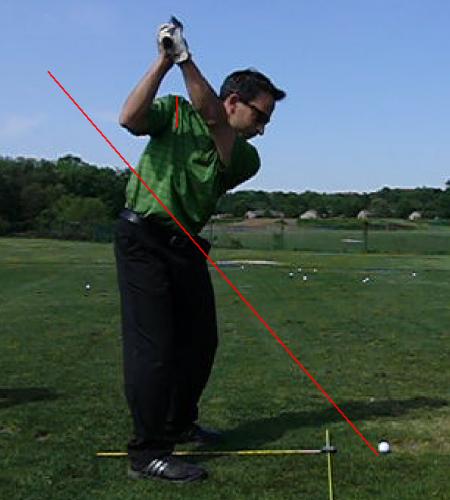
He looks like he’s got a normal backswing, but then gets the arms lifted a bit too steep at the top. Part of this is due to too little backswing shoulder turn but the other reason is that he’s got this problem with getting stuck so he deliberately tries to keep it a bit steeper on the backswing to escape the stuck position.
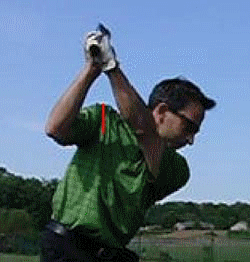
Take a close look at the animation of the start of his downswing. His right shoulder, if doing the lateral bend correctly, should move vertically down at the start of the backswing. But doesn’t it look more like he’s got an over the top move with his right shoulder? That means he’s got little or no lateral bend.
What may confuse you is that his arms and club are dropping onto a flatter plane. Planeology gives him “A” for getting on plane. But is that all there is to it?
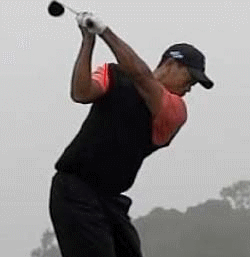
Contrast to Tiger Woods (when he was great in ‘08). Do you see the difference? Tiger’s shoulder is actually moving down and slightly away from the ball. This is hugely different than what Rich was doing.
Thus, Rich’s lack of lateral bend and right shoulder drop plus his disconnect the arms compensation move leads him to getting stuck.
Hence, the old saying that “two wrongs don’t make a right” certainly rings true in this case.
Let’s take a look at the Pink Pussycat, Paula Creamer’s swing to see how this same problem affects her swing.
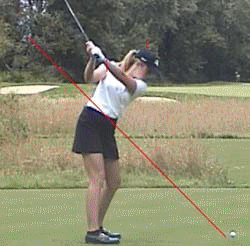
Do you see an even more exaggerated case of lack of lateral bend covered up by arm disconnection and fake shaft plane drop.
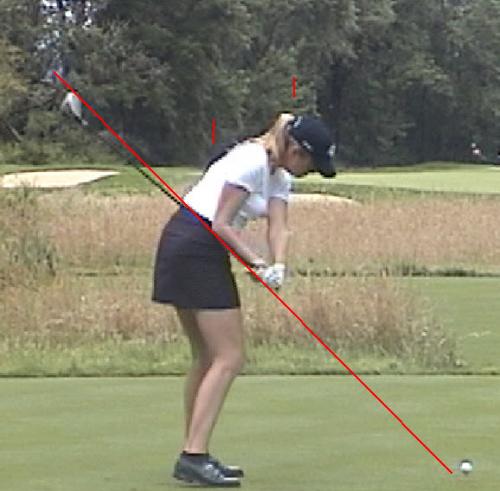
You can clearly see her right elbow stuck behind her right hip and the shaft becomes too flat at this point.
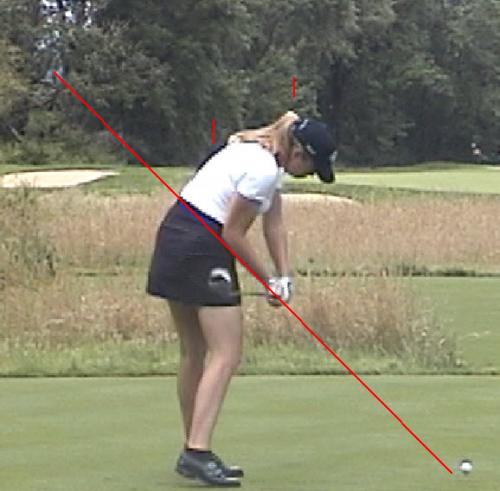
What to do from here???
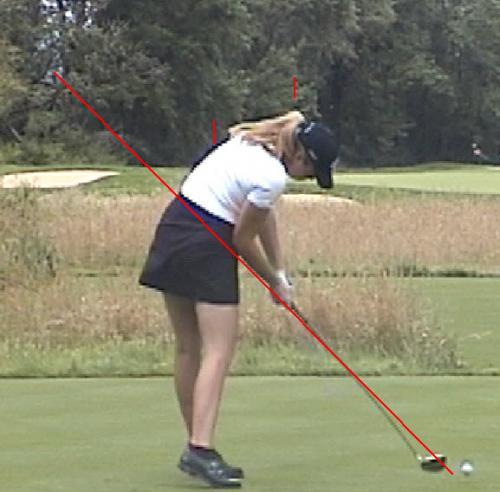
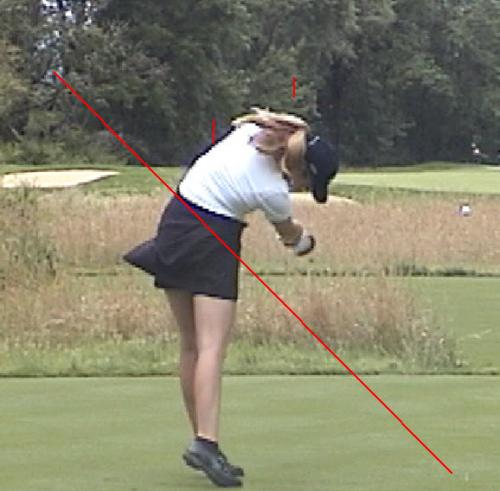
Stop the hips from rotating and throw the hands/arms at it. That might be the only way to rescue that swing once it is in such a difficult position.
The Real Golf Fix
The fix is exactly what I’ve been talking about. Develop some lateral bend, then get rid of the fake “shaft plane drop” and disconnected arm drop. So let’s see how Rich does it.
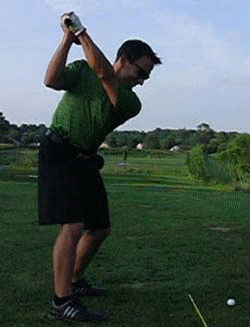
As you can see, Rich has some lateral bend now. So next, he definitely can get rid of the fake plane drop.
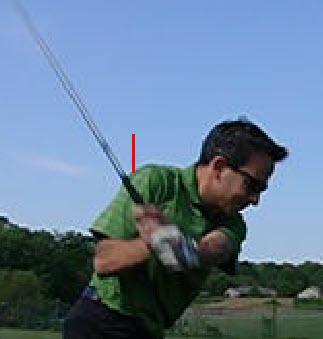
Old way has the over the top shoulder move with the disconnected arm drop and fake shaft plane flattening.
New way has Rich doing correct lateral bend without the arms disconnecting. His elbow is more in front of his right hip too.
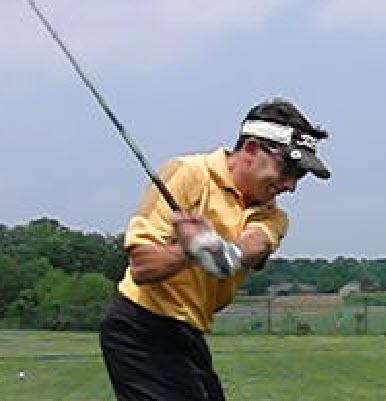
Another way to get stuck
As a general rule, a flat backswing + athletic movements = stuck. Tiger has shown that the flatter backswing combined with his tremendous lateral bend caused all kinds of driving problems. Luckily, Tiger has finally come to his senses, ditched the Hank Haney swing and has gone back to a more upright backswing plane.
So let me use scratch player David Keating to illustrate just how this works.
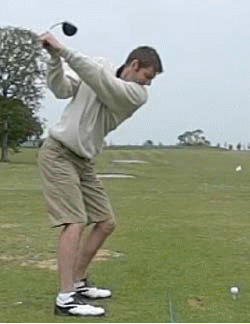
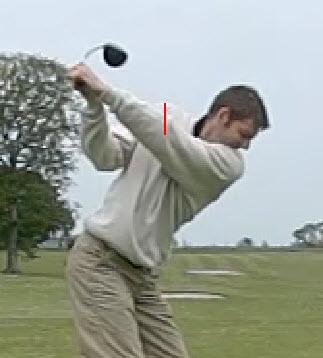
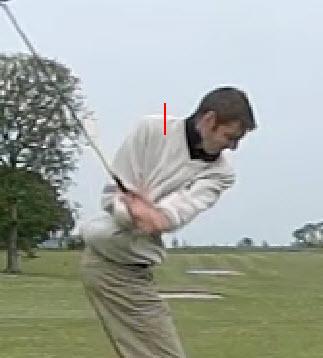
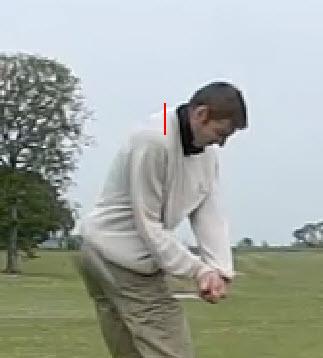
At the top of the backswing David is a bit too flat with his left arm position and club. But what makes it worse is that he’s got tremendous lateral bend. His right shoulder moves slightly back and away from the ball. This is the same type of move that Tiger makes with his right shoulder. And this is what gets him in trouble though. So let’s take a look at how this affects his swing plane and club path.
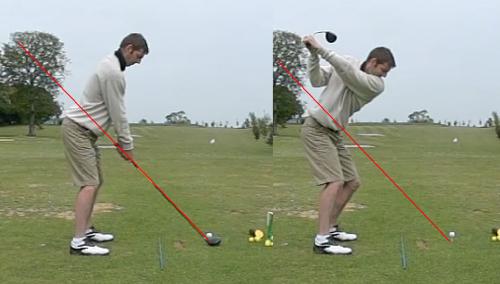
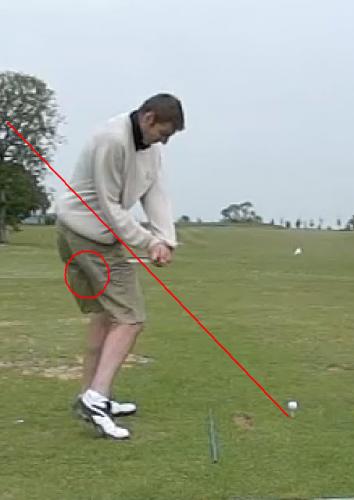
Once we understand what the body is doing it is the proper time to study planeology of David. So take a look at the position of the clubhead in the last photo (in the red circle). It is so far behind that the only path he can take to the ball is an in-to-out path which in turn causes several problems to arise.
One is that he must rotate the clubface more to compensate for his path being directed too far right of target. This causes the low hooks and occasional block right that plagued Tiger as well.
Second, club approaches the ball on a far too shallow path. This would cause fat shots if he didn’t slide his body farther left to avoid the bottom of his swing being behind the ball.
But as he slides too far left, he loses lordosis and disconnects his spine engine causing a stall. So you can see the tangled web of problems he faces due being a bit too flat plus his “athleticism.”
The Fix
A planeologist like Haney would have David simply rotate his left forearm to bring the club back in front of him. Simple fix right? It sure worked for Tiger. NOT!!!
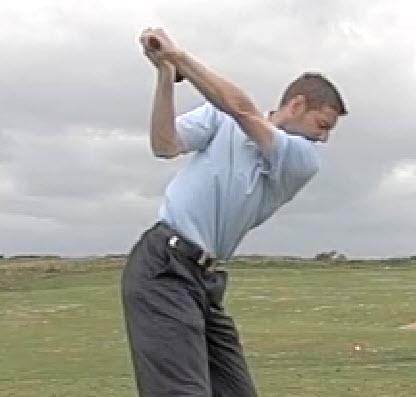
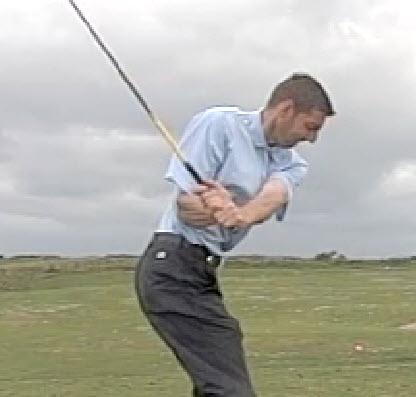
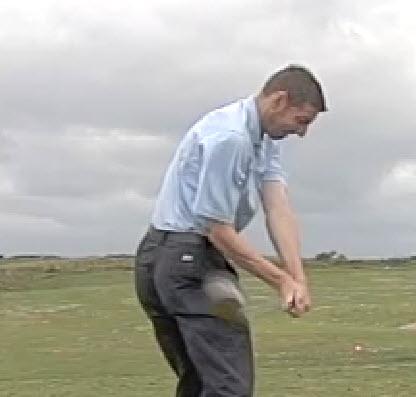
David’s fix was to get his arms higher and use his lateral bend in a good way. Once he did that, he worked on sliding less and retaining the lordosis in his lower spine so he could rotate more. This is what ultimately brings the club back down in front. Not that he’s perfect just yet. But it’s good enough to allow him to hit the ball straighter.
Tiger Update from US Open 2010
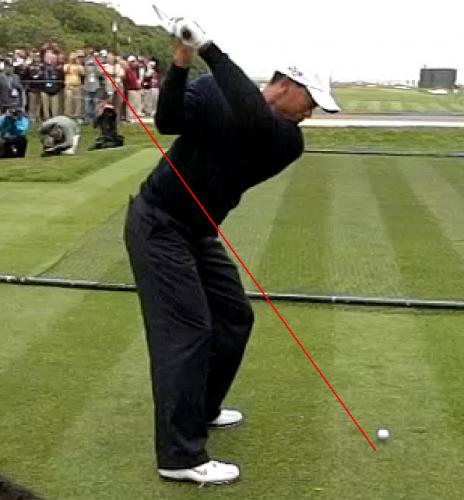
Notice Tiger has his left arm higher now. Club is not as laid off as it used to be.

Thus, now when he makes his athletic lateral bend with the shoulder drop, lat pull and elbow move, he does not get too flat as he did in ’09.


Club looks more in front than last year.
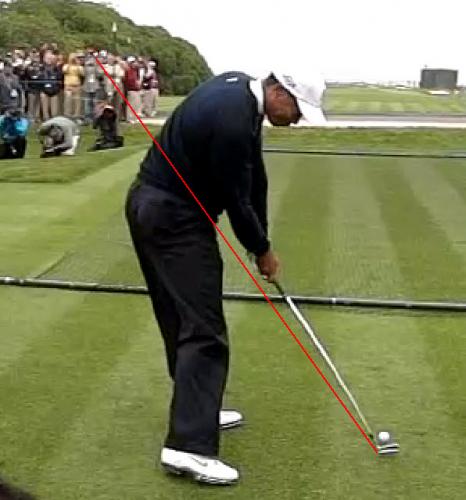
His hips are clearing better now and he’s not standing up like he did last year.
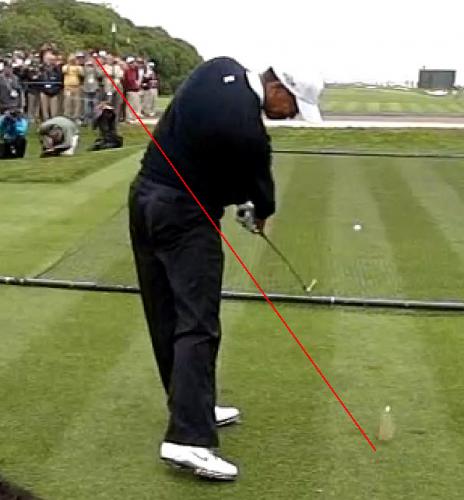
He’s not trying to follow through as much to the left nor is he rolling his hands to do that as we’ll see later from front view.
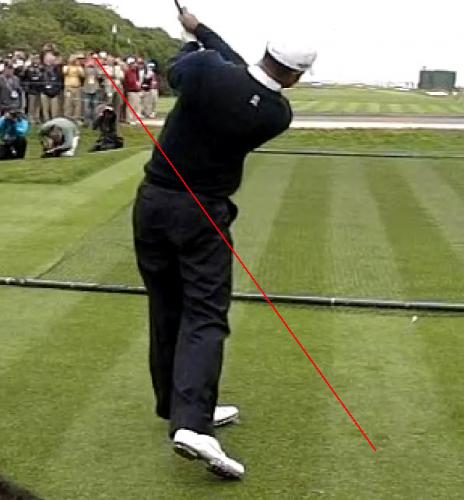
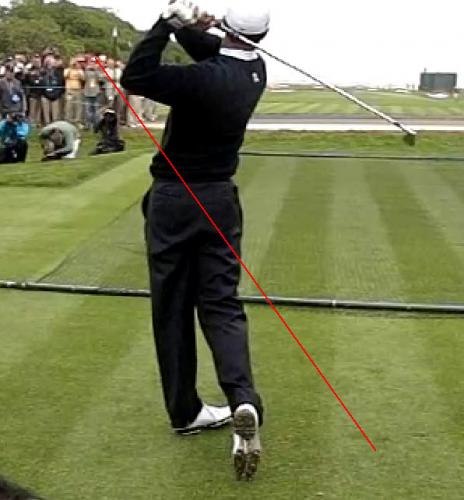
Looking like Tiger of old.
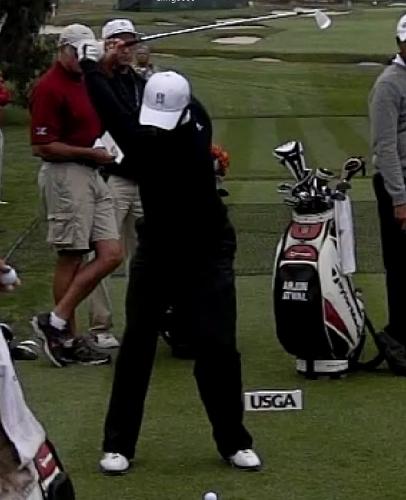
He’s looking like he’s got more weight on his right side.

He’s in good shape here.
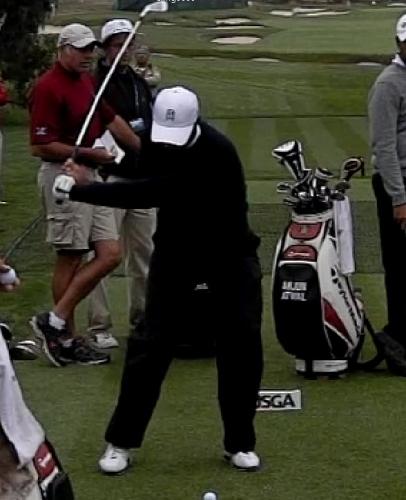
Less slide thus far.

He’s not imitating O’Meara anymore.

He’s actually sliding much less and straightening his left leg like in ’08.
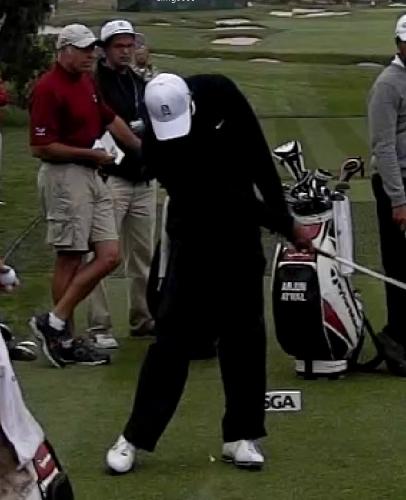
Hands are not rolling over like last year.

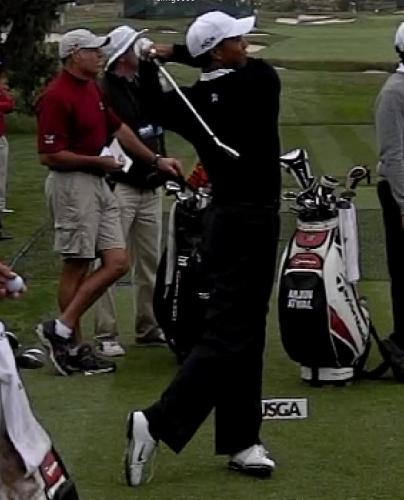
Tiger’s old follow through. Thus, while he may not be all the way back to his old form, it's more promising than last year.
So the moral to the story is that one mustn’t be too enamored with only the plane. While it does have a huge impact on how you hit the ball, one must also understand the movements of your body and spine that influence the plane.
Correction for Second Magical Key to the Spine Engine: Lumbar Lordosis:
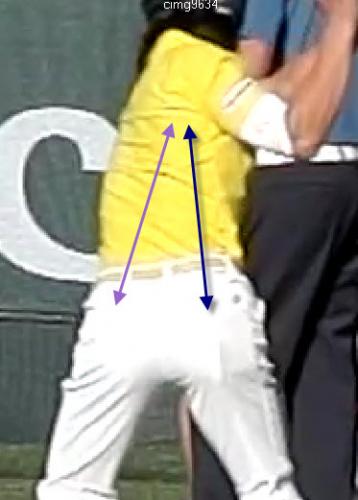
The wrong picture was inserted into the lordosis article and it was a pretty huge mistake. This is the picture that should have been there instead of a Rory picture.
The lavender arrows show how lordosis of the left lower spine should pull up towards the right shoulder. The dark blue arrow on the right side shows the lateral bend and lordosis in that area. Lordosis should feel like a duck’s tail feathers being pulled up.
But the average golfer does not have it so good. They typically don’t have the optimal moves and are taught just the fluff stuff and is rarely taught the real moves that the greatest golfers display. Imagine paying for a Ferrari, albeit unbeknownst to you, with a VW bug engine. You can own all the looks of a fast car but under the hood we know different.
The average golfer most likely has missing lateral bend or lordosis and this will certainly cause “golf technique” errors that are commonly Band-Aided and routinely covered up instead of fixed at the root. Therefore recurring problems will always exist because typical swing methods conjured up, consider the spine to be just a bony appendage on your back that stays in a two-dimensional straight line during the swing.
So let’s take a look at some commonly misdiagnosed swing flaws so that you can effectively correct the true source of the problems rather than Band-Aid them. So let’s take a look at how golfers can get stuck so that we can get to the root of this often misunderstood problem.
Here’s the great violinist from the Philadephia Orchestra, Rich Amoroso again to help us understand how he got stuck and how he fixed the problem. When he did this right for the first time, he exclaimed, “I’ve never done this before.” And based on what I’ve seen, most people don’t get this right and learn to live with their “disability.”



He looks like he’s got a normal backswing, but then gets the arms lifted a bit too steep at the top. Part of this is due to too little backswing shoulder turn but the other reason is that he’s got this problem with getting stuck so he deliberately tries to keep it a bit steeper on the backswing to escape the stuck position.

Take a close look at the animation of the start of his downswing. His right shoulder, if doing the lateral bend correctly, should move vertically down at the start of the backswing. But doesn’t it look more like he’s got an over the top move with his right shoulder? That means he’s got little or no lateral bend.
What may confuse you is that his arms and club are dropping onto a flatter plane. Planeology gives him “A” for getting on plane. But is that all there is to it?

Contrast to Tiger Woods (when he was great in ‘08). Do you see the difference? Tiger’s shoulder is actually moving down and slightly away from the ball. This is hugely different than what Rich was doing.
Thus, Rich’s lack of lateral bend and right shoulder drop plus his disconnect the arms compensation move leads him to getting stuck.
Hence, the old saying that “two wrongs don’t make a right” certainly rings true in this case.
Let’s take a look at the Pink Pussycat, Paula Creamer’s swing to see how this same problem affects her swing.

Do you see an even more exaggerated case of lack of lateral bend covered up by arm disconnection and fake shaft plane drop.

You can clearly see her right elbow stuck behind her right hip and the shaft becomes too flat at this point.

What to do from here???


Stop the hips from rotating and throw the hands/arms at it. That might be the only way to rescue that swing once it is in such a difficult position.
The Real Golf Fix
The fix is exactly what I’ve been talking about. Develop some lateral bend, then get rid of the fake “shaft plane drop” and disconnected arm drop. So let’s see how Rich does it.

As you can see, Rich has some lateral bend now. So next, he definitely can get rid of the fake plane drop.

Old way has the over the top shoulder move with the disconnected arm drop and fake shaft plane flattening.
New way has Rich doing correct lateral bend without the arms disconnecting. His elbow is more in front of his right hip too.

Another way to get stuck
As a general rule, a flat backswing + athletic movements = stuck. Tiger has shown that the flatter backswing combined with his tremendous lateral bend caused all kinds of driving problems. Luckily, Tiger has finally come to his senses, ditched the Hank Haney swing and has gone back to a more upright backswing plane.
So let me use scratch player David Keating to illustrate just how this works.




At the top of the backswing David is a bit too flat with his left arm position and club. But what makes it worse is that he’s got tremendous lateral bend. His right shoulder moves slightly back and away from the ball. This is the same type of move that Tiger makes with his right shoulder. And this is what gets him in trouble though. So let’s take a look at how this affects his swing plane and club path.


Once we understand what the body is doing it is the proper time to study planeology of David. So take a look at the position of the clubhead in the last photo (in the red circle). It is so far behind that the only path he can take to the ball is an in-to-out path which in turn causes several problems to arise.
One is that he must rotate the clubface more to compensate for his path being directed too far right of target. This causes the low hooks and occasional block right that plagued Tiger as well.
Second, club approaches the ball on a far too shallow path. This would cause fat shots if he didn’t slide his body farther left to avoid the bottom of his swing being behind the ball.
But as he slides too far left, he loses lordosis and disconnects his spine engine causing a stall. So you can see the tangled web of problems he faces due being a bit too flat plus his “athleticism.”
The Fix
A planeologist like Haney would have David simply rotate his left forearm to bring the club back in front of him. Simple fix right? It sure worked for Tiger. NOT!!!



David’s fix was to get his arms higher and use his lateral bend in a good way. Once he did that, he worked on sliding less and retaining the lordosis in his lower spine so he could rotate more. This is what ultimately brings the club back down in front. Not that he’s perfect just yet. But it’s good enough to allow him to hit the ball straighter.
Tiger Update from US Open 2010

Notice Tiger has his left arm higher now. Club is not as laid off as it used to be.

Thus, now when he makes his athletic lateral bend with the shoulder drop, lat pull and elbow move, he does not get too flat as he did in ’09.


Club looks more in front than last year.

His hips are clearing better now and he’s not standing up like he did last year.

He’s not trying to follow through as much to the left nor is he rolling his hands to do that as we’ll see later from front view.


Looking like Tiger of old.

He’s looking like he’s got more weight on his right side.

He’s in good shape here.

Less slide thus far.

He’s not imitating O’Meara anymore.

He’s actually sliding much less and straightening his left leg like in ’08.

Hands are not rolling over like last year.


Tiger’s old follow through. Thus, while he may not be all the way back to his old form, it's more promising than last year.
So the moral to the story is that one mustn’t be too enamored with only the plane. While it does have a huge impact on how you hit the ball, one must also understand the movements of your body and spine that influence the plane.
*********************
Correction for Second Magical Key to the Spine Engine: Lumbar Lordosis:

The wrong picture was inserted into the lordosis article and it was a pretty huge mistake. This is the picture that should have been there instead of a Rory picture.
The lavender arrows show how lordosis of the left lower spine should pull up towards the right shoulder. The dark blue arrow on the right side shows the lateral bend and lordosis in that area. Lordosis should feel like a duck’s tail feathers being pulled up.

